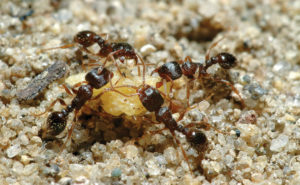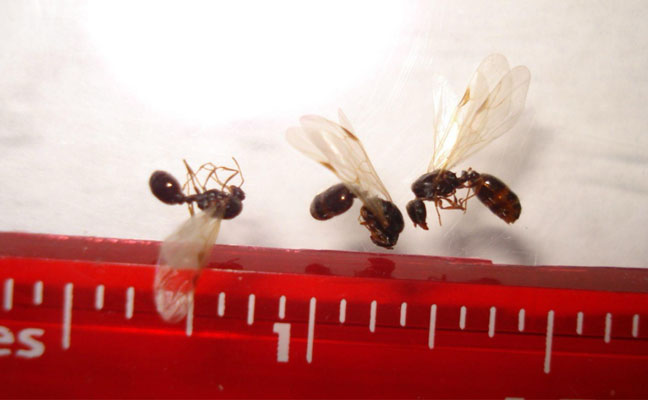
Photo: ©Gene White
As their common name implies, pavement ants are commonly found in urban areas, particularly on sidewalks and pavements. There are 10 species in the Tetramorium caespitum complex, which until 2017 was the only scientific name for pavement ants overall. Today, the pavement ant species found in North America is classified as the subspecies T. immigrans, while the other nine species are primarily confined to Europe (Wagner et al, 2017). It’s this subspecies on which this article will focus.
Pavement ants are known for their ability to excavate soil and create nests under sidewalks and driveways. They typically feed on various food sources, including other insects, sweets and greasy foods. Pavement ants are attracted to various food scraps, including potato chips, and they are known to gather around dropped food. This is one of the ways people may notice their presence indoors.
Notable biology traits
According to Bruder and Gupta (1972), pavement ants are relatively small, measuring between 2.5 millimeters to 4 millimeters in length. They have a slender and segmented body with a distinct waist, which is a characteristic of all ants.
Pavement ants are typically dark brown or black in color, although that can vary depending on location and environment. They have light-colored legs and antennae.
The head shape of pavement ants is relatively flat and rectangular compared to other ant species, with straight mandibles that are not strongly curved. Its thorax has two small spines, called propodeal spines, which point backward. These spines are not as pronounced as those found in other ant species.
Pavement ants have a petiole, which is the narrow section of the ant’s waist that connects the thorax and the gaster. Their petiole has two nodes, which are relatively small compared to those of other ant species.
Swarm characteristics
Bruder and Gupta (1972) found that pavement ants typically have a single queen in a colony; they also can have up to several thousand workers. The winged reproductives can swarm anywhere from late March to late July, depending on weather conditions.
Newly dealated females — those who removed their wings — start laying eggs within 48 to 72 hours after swarming. They can produce five to 20 eggs per day. The eggs take about 18 days to develop into larvae, which go through three instars before becoming pupae. Worker development in established colonies ranges from 43 to 63 days, and a colony can produce up to 200 reproductive individuals per year (Sano, Bannon, & Greene, 2018).
Ready for battle
Starting with the wars in which they engage, pavement ants defend their colony against neighboring ant colonies and engage in conspicuous territorial wars. To accomplish this, they must be able to distinguish their nestmates from non-nestmates.

Pavement ant winged reproductives are usually predominantly of one sex within each nest. Photo: Dr. Mohammed El Damir, BCE
Pavement ants use cuticular hydrocarbon profiles to identify ants that are conspecific — in colonies of other pavement ants — and heterospecific — in colonies of other ant species (Sano et al., 2018). These recognition cues are made up of mixtures of long-chain hydrocarbon compounds on their cuticles (exoskeletons).
The ants assess these cues to decide whether to fight or accept the presence of other ants. The wars involving pavement ants are organized based on this assessment, and the fighting is ritualized, with minimal casualties despite the involvement of large numbers of ants.
Although pavement ants are not aggressive toward humans, they may inflict a pinch if handled. They display an impressive level of organization and aggression when defending their territory against neighboring colonies.
Prevention and control
Treatment for pavement ants can be conducted both indoors and outdoors, depending on the location and severity of the infestation.
Indoors, appropriately labeled baits can be placed near ant trails or other areas where ants are commonly seen, such as near kitchen counters or trash cans. Baits also can be placed near entry points to prevent ants from entering the house.
Outdoors, appropriately labeled perimeter insecticide applications can be effective in suppressing pavement ant populations. Residual insecticides can be applied along entry points and potential access areas to act as a barrier, discouraging ants from entering the structure.
In general, exterior treatments, including perimeter insecticide applications and baiting, have effectively controlled pavement ants and other ant species. However, it is important to note that the efficacy of specific treatments may vary depending on factors such as environmental conditions and the types of control products used.
Prevention is an effective long-term solution for managing many pest infestations, including pavement ants. To prevent pavement ants from entering a building, it’s important to practice exclusion measures such as sealing and caulking any potential entry points, including cracks, crevices and holes. It’s also important to avoid allowing tree and shrub parts to touch the walls and roofs of structures, which can easily create superhighways for ants to enter and exit.
Proper sanitation practices, such as emptying trash cans daily, removing infested potted plants, and thoroughly cleaning up spilled food, also can help prevent ant infestations of all types.
Effective water management, such as repairing leaky sinks and fountains, and increasing ventilation in damp areas, also can help prevent ants from being attracted to a building.
Overhangs can be a potential entry point for ants, especially if they provide direct access to a building. Additionally, sealing any gaps or cracks where the overhang meets the building can help prevent ant entry.

Photo: Dr. Mohammed El Damir, BCE
Pavement ants are soil dwellers
In a study conducted by Jang et al., (2011) to investigate the seasonal activity and nest site preference of pavement ants in urban environments, it was discovered that these ants were more inclined to nest in soil rather than in pavement or other structural elements. Despite their name, pavement ants displayed remarkable adaptability and were found to nest in various urban settings, including cracks in pavement and the voids beneath concrete sidewalks and driveways.
This research highlights the flexibility and resourcefulness of pavement ants in selecting nesting sites that best suit their needs, even in an urban landscape. In cold weather, they tend to nest in sheltered spaces, such as underneath slabs. Their ability to survive and remain active during the winter months in these protected environments showcases their resourcefulness and ability to thrive in various conditions. — M.E.
References
- Bruder, K.W., & Gupta, A.P. (1972). Biology of the Pavement Ant, Tetramorium caespitum (Hymenoptera: Formicidae). Annals of the Entomological Society of America, 65(2), 358–367. DOI.org/10.1093/aesa/65.2.358
- Jang, E.B., Lightle, D.M., Rust, M.K., & Reierson, D.A. (2011). Seasonal activity and nest site preference of pavement ants (Hymenoptera: Formicidae) in an urban environment. Journal of Economic Entomology, 104(4), 1315-1321.
- Radchenko, A.; Czechowski, W.; Czechowska, W. 1998: The genus Tetramorium Mayer (Hymenoptera, Formicidae) in Poland – a survey of species and a key for their identification. Annales Zoologici 481: 107–118.
- Rust, M.K., Reierson, D.A., & Dickson, C.G. (2004). Control of pavement ants (Hymenoptera: Formicidae) with baits of different matrices. Journal of Economic Entomology, 97(4), 1179-1184.
- Sano, K., Bannon, N., & Greene, M.J. (2018). Pavement Ant Workers (Tetramorium caespitum) Assess Cues Coded in Cuticular Hydrocarbons to Recognize Conspecific and Heterospecific Non-Nestmate Ants. Journal of Insect Behavior, 31(2), 186–199. DOI.org/10.1007/s10905-017-9688-7
- Wagner, H.C., Arthofer, W., Seifert, B., Muster, C., Steiner, F.M., Schlick-Steiner, B.C. (2017). “Light at the end of the tunnel: Integrative taxonomy delimits cryptic species in the Tetramorium caespitum complex (Hymenoptera: Formicidae).” Myrmecological News, 25, 95–129.
Thanks for sharing this insightful information about pavement ants! It’s fascinating to learn about their biology and behavior. I appreciate the detailed overview of their physical characteristics, swarm dynamics, and their unique way of waging wars.
Your mention of prevention and control measures is especially helpful. I believe awareness about these practices is crucial for both homeowners and pest control professionals.